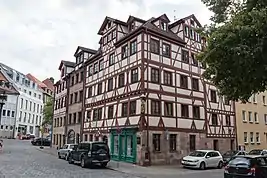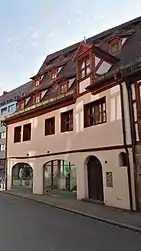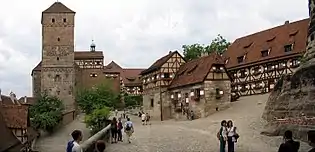Old Town Friends Nuremberg
The Old Town Friends Nuremberg (German: Altstadtfreunde Nürnberg e. V.) are an association that supports the preservation and restoration of the existing historical old town houses and other architectural monuments in Nuremberg that are worth preserving. Founded on January 25, 1950 under the name "Association of Friends of the Old Town Nuremberg". [1] The Old Town Friends grew from a small association with 135 members to their current size with about 6,000 members (status: 2002). This makes them the largest culturally active citizens' association in Nuremberg. [2] Since June 2010 the chairman has been Karl-Heinz Enderle.
Activities
General

The association works to preserve the old town of Nuremberg, since the devastation it suffered in World War Two. It aims to ensure new building work is carried out that is in line with the old town. The old town friends also buy old town houses for this purpose - sometimes they get them through inheritance or donation - and renovate them. The association is committed to the preservation of monuments. Among other things, it works to try to highlight the history and importance of Nuremberg's old town to citizens and tourists . This happens through the old town walks (in which more than 250,000 people took part until 2002), group tours through the old town, active participation in the day of the open monument, monthly lectures and especially through the annual publication of the old town reports in Nuremberg. Between 1972 and 1978, the association achieved a groundbreaking success with the rescue of four medieval half-timbered houses on Unschlittplatz, which had already been released for demolition.
By 2002, the association had carried out 220 construction projects, including 38 half-timbered buildings, the preservation of nine houses through purchase and renovation, and eight others through resale. From 1973 to 2002, the Friends of the Old Town generated a total of over 15 million euros through these measures.
The influence of the association on the development of the city of Nuremberg was shown in the efforts of the old town friends to design the Augustinerhof in 1996. An architectural draft for this area in the centre of the old town - in the immediate vicinity of the main market was intended by the city planners of Nuremberg to give the city centre a "modern flair." In the opinion of the friends of the old town, the project was likened to a "sliced bratwurst" that would not have fit in the structural context of the old town of Nuremberg and its roof landscape. In a referendum, the first in a Bavarian city, voted on January 14, 1996 67,284 voters against the new construction project and only 30,637 for it, which prevented the implementation. In 2009, the association articulated its resistance to the new construction of the city library, which was unsuccessful.
Projects



In 2005 the Old Town Friends renovated three medieval craftsmen's houses (German: Handwerkerhäuser) from the 15th century on Kühnertsgasse. Since autumn 2011, the Old Town Friends have operated a museum in these buildings.
The Old Town Friends have done much work in restoring houses, especially in the street 'Weißgerbergasse' This street has around twenty medieval half-timbered houses[3] that survived the heavy air raids on Nuremberg.[4] It therefore reflects a piece of historic Nuremberg, in particular an old craft district within the Castle area. In the years around 1970, the half-timbering in the Weißgerbergasse was still plastered. The old friends helped renovate the houses Weißgerbergasse No. 23, 26, 30 and 35 to uncover their half-timbered facades and dormer windows.[5] On house numbers 16 and 25 on the street you can find two of the Nuremberg style "Chörlein", or bay windows, on the house facade, which loosened the strict image of the Nuremberg house facades. They also served to observe the street happenings.[6] The half-timbered excavations that the Old Town Friends brought about on the street was applauded by many, but others criticised it, arguing that the street had been turned into a showcase and a tourist attraction.
In 1997 the Old Town Friends bought the corner house Irrerstrasse 1, a former bath house from 1509. The house forms the entrance to Weißgerbergasse.[7] From 2004 - 2007 the Old Town Friends repaired the former bath house and restored the roof structure based on the historical model by removing its emergency post-war roof.[8]
Likewise, the Old Town Friends bought the historic former tanner's house at Weißgerbergasse 10 in 2000 and renovated it as an “Erich-Mulzer-Haus” with an expenditure of 1.5 million euros and then set up their office there.[9] At the end of 2006 the Old Town Friends were able to put the roof bay on the house at Weißgerbergasse 8.[10]
The Old Town Friends renovated an old barn in Zirkelschmiedsgasse and have used it as an events location since around 2002.
Current projects
In 2018 the association carried out the reconstruction of the inner courtyard of the renaissance era townhouse The Pellerhaus. The courtyard was completed in 2018 by raising 5 million euros through donations and with their own funds. The organisation is still pushing to reconstruct the complete building and the discussion about this is ongoing.
The old town friends are also committed to moving the Neptune Fountain back to the main market .[11]
The association is currently reconstructing a former tanner's house from the 17th century called Hintere Ledergasse 43. The house burned in WW2 and had an emergency post war roof. It was near collapse and scheduled for demolition in 2002, but the old town friends came as an investor and saved the house. They are currently reconstructing much of the house and courtyard to the original 17th century designs, especially the upper floors and roof. It is expected to be completed in spring 2021.[12][13][14]
They are also looking at restoring the late gothic Pilatushaus from 1489 on the Tiergärtnertorplatz. It is considered a top priority by the organisation because it is at risk of collapse. While the house looks good from the outside, the inside timbering has to be supported everywhere. It stands in a prominent position below the castle and is one of the city's most important architectural monuments. The chairman of the old town friends believes the renovation would costs about five million euros. He would like to run gastronomy in the Pilatushaus and create three apartments inside. Negotiations with the city were expected to take place in March 2020.[15]
- Photographs of buildings associated with the organisation
 The former bathhouse on Irrerstrasse, Nuremberg.
The former bathhouse on Irrerstrasse, Nuremberg. Weissgerbergasse 08, Nuremberg.
Weissgerbergasse 08, Nuremberg. Weissgerbergasse 10, Nuremberg.
Weissgerbergasse 10, Nuremberg. Weißgerbergasse, Nuremberg.
Weißgerbergasse, Nuremberg. The recently reconstructed Pellerhof Courtyard.
The recently reconstructed Pellerhof Courtyard. The 17th century former tanners house 'Hintere Ledergasse 43' before its restoration by the Old Town Friends.
The 17th century former tanners house 'Hintere Ledergasse 43' before its restoration by the Old Town Friends. The restored barn Zirkelschmiedsgasse 30, Nuremberg.
The restored barn Zirkelschmiedsgasse 30, Nuremberg. Facade of the restored barn Zirkelschmiedsgasse 30, Nuremberg.
Facade of the restored barn Zirkelschmiedsgasse 30, Nuremberg.
Awards
- 1992 Prize of the Dr. Lorenz Tucher Foundation
- 2002 prize in the facade competition of the Sparkasse Nürnberg, second prize group (1,500 euros) for the half-timbered house Pfeifergasse 7
- 2002 Bavarian State Foundation Culture Award (25,000 euros)
- 2003 recognition (5,000 euros) for the town house Pfeifergasse 7 as part of the monument award of the Hypo-Kulturstiftung
- 2003 Award in the facade competition of the Sparkasse Nürnberg: Second place with 1,000 euros for the three-story house with gable in Mostgasse 9
- 2004 Bavarian developer award for urban renewal - vital inner city: recognition for Zirkelschmiedsgasse (Kulturscheune) and Pfeifergasse 7
Literature
- Erich Mulzer (2000), Michael Diefenbacher, Rudolf Endres (ed.), Altstadtfreunde, Nuremberg City Lexicon (Stadtlexikon Nürnberg) (in German) (2nd, revised ed.), Nuremberg: W. Tümmels Verlag, pp. 66 f., ISBN 3-921590-69-8
- Altstadtfreunde Nürnberg e.V. (Ed.): Altstadtmacher - 30 years Altstadtfreunde Nürnberg, editor: Inge Lauterbach, text: Peter Fleischmann, photographs: Herbert Liedel, Bernd Telle, Günter Derleth. Nuremberg: Tümmels, 2003, 144 pp., ISBN 3-921590-06-X
- Nuremberg old town reports. Annual report and essays by Old Town Friends Nuremberg, ed. from the Altstadtfreunden Nürnberg e.V .; appears annually, No. 1 (1976), Nuremberg: Altstadtfreunde
- Wiltrud Fischer Pache: Nuremberg Old Town Reports. Ed. Von den Altstadtfreunden Nürnberg eV, No. 14 (1989) 88 pages, No. 15 (1990) 96 pages, No. 16 (1991) 96 pages, in: Mitteilungen des Verein für Geschichte der Stadt Nürnberg Volume 80, 1993, p. 273 - online
- Altstadtfreunde Nürnberg e. V. (2010), Kühnertsgasse 18-20 – A journey through the centuries (in German), Nürnberg
References
- "Dr. Hellmut Kunstmann". Fränkische Schweiz - Society e.V. Archived from the original on 2007-12-30. Retrieved 2010-12-09.
- "Erich Mulzer gives up chairmanship after 30 years. The old town friends get a boss, Inge Lauterbach". Archived from the original on 2007-09-27. Retrieved 2020-04-10.CS1 maint: bot: original URL status unknown (link), Nürnberger paper from 8. April 2004
- Erich Mulzer: The half-timbered building in Nuremberg. In: Communications of the Association for the History of the City of Nuremberg (MVGN), Band 55 (1967/68), Seite 300–331
- "Press and Information Office of the City of Nuremberg: Air War and Destruction in Nuremberg". Archived from the original on 2007-09-14. Retrieved 2020-04-10.CS1 maint: bot: original URL status unknown (link)
- Completed construction projects of the Nuremberg Old Town Friends - PDF
- H. Hedayati: Chörlein. A walk in the old town of Nuremberg.Archived 2018-03-23 at the Wayback Machine July 2004 (revisited 2011)
- "Haus Irrerstraße 1 - former bath house for the Irrerbad". Archived from the original on 2012-06-30. Retrieved 2020-04-10.CS1 maint: bot: original URL status unknown (link)
- "ziegler-architekt: nurnberg bathhouse". ziegler-architekt.de/. April 2020.
- "Erich-Mulzer-Haus 'planned. In: Nürnberger Nachrichten of January 19, 2006". Archived from the original on 2007-12-30. Retrieved 2020-04-10.CS1 maint: bot: original URL status unknown (link)
- "stadtbild-deutschland.org/". April 2020.
- Horn, Judith (April 2020). "When Neptune was still enthroned on the main market". nordbayern.de/region/nuernberg.
- "Rettung in Nürnberg: Uralte Gerberei vor dem Abriss bewahrt". nordbayern.de (in German). Retrieved 2020-11-27.
- "Sanierung Hintere Ledergasse 43 - Stadterneuerung Altstadt". www.nuernberg.de. Retrieved 2020-11-27.
- "The Gerberhaus Hintere Ledergasse 43 Supported by means of urban development funding" (PDF). imperia: 1–31. 2020 – via altstadtfreunde nürnberg.
- "Nürnberger Altstadtfreunde retten seit 70 Jahren alte Häuser". BR24 (in German). 2020-01-28. Retrieved 2020-11-27.
External links
- Altstadtfreunde Nürnberg e.V.
- Nürnberger Altstadtfreunde as builders (PDF-Datei; 3,27 MB)
- Kühnertsgasse 18-22 auf www.altstadtfreunde-nuernberg.de
- Craftsmen's houses in Kühnertsgasse have been completed on www.nz-online.de
- Altstadtfreunde Nürnberg: Weißgerbergasse 10 - the Dr.-Erich-Mulzer-House
- Ziegler Architect: Bathhouse
